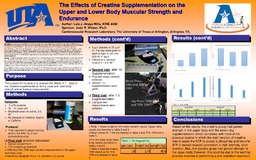| dc.description.abstract | •BACKGROUND: Since its discovery, many studies have been done on creatine (Cr) and it is an ergogenic supplement that increases short term, high intensity exercise performance. Most of the total Cr (95%) in humans is located in the skeletal muscle, in which 60% is phosphocreatine and the remainder is free Cr (1,2). The purpose of this study was to evaluate the effects of 7 – days of oral creatine supplementation during upper and lower body strength and endurance measurements.
•METHODS: Students at UTA and the Kinesiology department volunteered to participate in this study, five men (M; age 24 + 3.03 yrs, height 1.73 + 0.04 m, and weight 80.6 + 8.75 kg). Participants had an average exercise routine of about 3 d. W-1 and were asked to maintain the same exercise routine during the study. They did not have any allergies to creatine, aspirin, or caffeine. They reported on three nonconsecutive days for measurements. On the first visit, after signing the consent form, a pre-test on their 1RM and 70% of 1RM was determined for the upper and lower body. A placebo or creatine supplementation was then given for seven days. Post-testing was determined on the 2nd visit after the seven days of placebo. A second supplement was given for the following seven days (Creatine) before the 3rd visit for their last measurements.
•RESULTS: The means for upper body 1 repetition max (1RM) (in pounds) are: pre-test placebo 130 + 27.57, post-test placebo 142 + 31.87, pre-test Cr 142 + 31.87, post-test Cr 150 + 35.21; the 70% of 1RM for repetition max (RM) (in reps) are: pre-test placebo 13.6 + 2.42, post-test placebo 10.8 + 1.6, pre-test Cr 10.8 + 1.6, post-test Cr 11.2 + 1.33. Now, for the lower body means calculated are: 1RM (in pounds): pre-test placebo 392 + 85.65, post-test placebo 414 + 72, pre-test Cr 414 + 72, post-test Cr 426 + 70.60; for the 70% of 1RM (in reps): pre-test placebo 14.2 + 3.97, post-test placebo 13.6 + 3.38, pre-test Cr 13.6 + 3.38, post-test Cr 13.2 + 3.19. There were no significant differences found in the upper body 70% of 1RM placebo nor Cr. Moreover, no significant differences were found in the lower body 1RM placebo and Cr, nor, 70% RM placebo and Cr. However, there were significant differences found in the upper body 1RM placebo and Cr (p<0.05).
•CONCLUSION: Based on the results, the creatine group had gained strength in the upper body with the seven-day supplementation which correlates with most of the previous studies in which the main function of Cr was to assist the ADP to accept a phosphate and become ATP in sustain muscle contraction in high intensity, short duration. Also, the placebo group had gained strength in the upper body, however, this could be due to the learning process involved in performing a one repetition maximum. | en_US |

